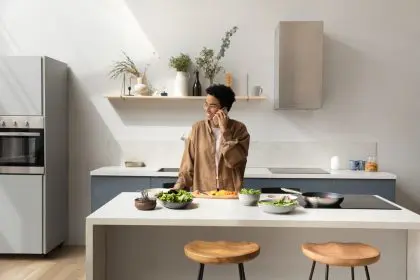The moment you walk into certain homes, something feels off. Your head starts pounding, your eyes itch, or your nose won’t stop running. Maybe you feel unusually tired, dizzy, or even anxious without a clear reason. These aren’t random occurrences. Some homes can indeed make people feel physically or emotionally sick — and the reasons are both complex and alarming.
Whether it’s an older house with decades of dust or a modern space packed with synthetic materials, indoor environments carry hidden dangers that many homeowners overlook.
Indoor air quality
One of the most common reasons a home makes you feel sick is poor indoor air quality. Unlike outdoor air, which circulates more freely, indoor air gets trapped — and with it, pollutants, chemicals, and allergens.
Common indoor pollutants include:
- Volatile Organic Compounds (VOCs) from paint, furniture and cleaning supplies
- Mold spores from moisture issues, even those invisible to the eye
- Pet dander and dust mites in upholstery, carpets and bedding
- Carbon monoxide and radon, both odorless, colorless gases
Even a freshly renovated home can be a culprit. Those “new house smells” often come from off-gassing of synthetic materials — a chemical cocktail that can irritate lungs, eyes and sinuses.
Hidden mold
You don’t need to see mold for it to be a problem. Mold can grow behind walls, under carpets, or in ventilation systems. Some types produce toxins that cause respiratory issues, skin irritation, fatigue and headaches. For people with asthma, autoimmune issues, or weakened immune systems, exposure can be especially dangerous.
Moisture is the breeding ground. Leaky roofs, burst pipes and even high humidity levels can encourage mold growth in less than 48 hours. What’s worse, symptoms caused by mold often mimic other illnesses, making it harder to trace the cause.
If you’ve noticed a musty smell, discolored patches on the wall, or worsening allergy symptoms at home, it may be time to investigate deeper.
Off-gassing furniture
That stylish new sofa or cabinet could be slowly releasing toxic fumes into your living space. Off-gassing is the process where certain materials emit volatile organic compounds. These VOCs are commonly found in pressed wood products, carpets, vinyl flooring, paints and foam mattresses.
Short-term exposure to VOCs can cause dizziness, nausea, headaches and eye or throat irritation. Long-term exposure has been linked to liver and kidney damage, and even certain cancers.
The solution isn’t to throw out everything you own. Instead, look for certifications like GREENGUARD Gold or products labeled as low-VOC when making new purchases. Increase ventilation when introducing anything new to your space.
Poor ventilation
A closed-up home might feel cozy, but without fresh air moving through, it becomes a breeding ground for airborne irritants. Stale air means higher concentrations of allergens, bacteria and pollutants — especially in homes that rely heavily on heating or air conditioning.
Older homes may have insufficient airflow due to outdated construction. Meanwhile, modern homes built for energy efficiency can be so airtight that they trap pollutants inside.
Opening windows when possible, using HEPA air purifiers, and ensuring that exhaust fans in bathrooms and kitchens function properly can help keep indoor air healthier.
Toxic cleaning products
Ironically, the very products used to “clean” your home can sometimes do more harm than good. Many conventional cleaning sprays, laundry detergents and air fresheners contain chemicals that are harmful when inhaled or absorbed through the skin.
Strong artificial fragrances can trigger migraines, asthma attacks or rashes. Disinfectants and bleach-based products, when overused or mixed, release fumes that are particularly harsh on the respiratory system.
Switching to natural alternatives like vinegar, baking soda or certified green cleaners can dramatically reduce your exposure to these hidden hazards.
Emotional stress triggers
Not all sickness is physical. Some homes carry a heavy emotional weight — due to past trauma, clutter, noise or negative memories. Our brains respond to our environment on a subconscious level, releasing stress hormones when the surroundings feel chaotic, unsafe or depressing.
For instance, an overly cluttered space can overwhelm the senses and contribute to anxiety or depression. Dim lighting or a lack of natural light may also affect mood and energy levels.
Creating a calming, organized and nurturing home environment is essential for emotional well-being.
Allergens and dust
Even the cleanest-looking homes harbor layers of dust and allergens. These particles collect on surfaces, in air ducts and inside mattresses or upholstered furniture. If left unchecked, they can cause sneezing, congestion and itchy eyes.
Vacuuming with HEPA filters, dusting with damp cloths and regularly washing linens can keep allergen levels low. Don’t forget the air ducts — professional cleaning every few years can make a big difference.
Building materials in older homes
Homes built before the 1980s may contain hazardous materials like asbestos or lead paint. Disturbing these materials during renovations or through normal wear and tear can release dangerous particles into the air.
Lead poisoning, even in small doses, can affect brain development in children. Asbestos fibers, when inhaled, increase the risk of lung disease and certain cancers. If your home is older, it’s important to hire certified professionals for inspections and safe removal.
Protecting yourself
If your home makes you feel sick, listen to your body. Don’t brush it off as imagination. There are practical steps you can take:
- Use a home air quality monitor to detect common pollutants
- Invest in air purifiers with true HEPA filters
- Improve ventilation with fans or open windows
- Inspect for moisture, leaks and mold regularly
- Choose natural, low-toxicity products whenever possible
- Declutter and create open, breathable spaces
- Bring in houseplants that purify the air
The spaces we live in have a profound effect on our physical and emotional health. When a home makes you feel sick instantly, it’s a warning — not a mystery. By understanding what makes some homes toxic, you empower yourself to take action — and make the place you live in one that truly supports your health.

















